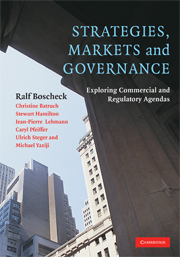Book contents
- Frontmatter
- Contents
- List of Figures, Boxes and Tables
- Acknowledgments
- Preface
- Notes on Contributors
- Part I Introduction and overview
- Part II Firm-level
- 2 Competitive advantage and the regulation of dominant firms
- 3 Delegating regulation: Supply-chain management, partnering and competition policy reforms
- 4 Diffusion of corporate governance regulation: France, Germany, the UK and the USA
- 5 Corporate governance after Enron et al.
- 6 Tackling healthcare fraud!?
- 7 Watchdog and proxy war campaigns against firms
- 8 Oil and conflict: Lundin Petroleum's experience in Sudan
- Part III Industry-level
- Part IV Country/International level
- Part V An observation in closing
- Index
4 - Diffusion of corporate governance regulation: France, Germany, the UK and the USA
Published online by Cambridge University Press: 06 July 2010
- Frontmatter
- Contents
- List of Figures, Boxes and Tables
- Acknowledgments
- Preface
- Notes on Contributors
- Part I Introduction and overview
- Part II Firm-level
- 2 Competitive advantage and the regulation of dominant firms
- 3 Delegating regulation: Supply-chain management, partnering and competition policy reforms
- 4 Diffusion of corporate governance regulation: France, Germany, the UK and the USA
- 5 Corporate governance after Enron et al.
- 6 Tackling healthcare fraud!?
- 7 Watchdog and proxy war campaigns against firms
- 8 Oil and conflict: Lundin Petroleum's experience in Sudan
- Part III Industry-level
- Part IV Country/International level
- Part V An observation in closing
- Index
Summary
Introduction
Numerous developed nations have introduced legislation and codes to regulate corporate governance over the last years. Efforts to harmonize corporate governance regulations can be noticed, especially in the European Union (EU), but also on a more international level through the OECD. Moreover the discussion in the media about corporate governance is picking up pace.
But what has caused this recent “excitement”? At the beginning of the twenty-first century, investors' trust was severely shaken, not only through the always cited – and I am not trying to be the exception – collapse of Enron in 2001, but also through other corporate disasters like Vivendi in France in 2002. Authorities felt the need to react and to create and amend regulations concerning corporate governance. Certainly the most prominent example of corporate governance regulation is the Sarbanes-Oxley Act (SOX or Sarbox) in the United States, which became effective on July 30, 2002 and is still being updated.
The Sarbanes-Oxley Act has been the first real change in US corporate governance regulations since the Investment Advisor Act of 1940 and according to Wiesen, it is the most important change after the Securities Exchange Act of 1934. Like the Sarbanes-Oxley Act, “the 34 Act” was preceded by a crisis and the second worst loss of investors' confidence in the stock market – the world economic crisis of 1929.
- Type
- Chapter
- Information
- Strategies, Markets and GovernanceExploring Commercial and Regulatory Agendas, pp. 69 - 87Publisher: Cambridge University PressPrint publication year: 2008



